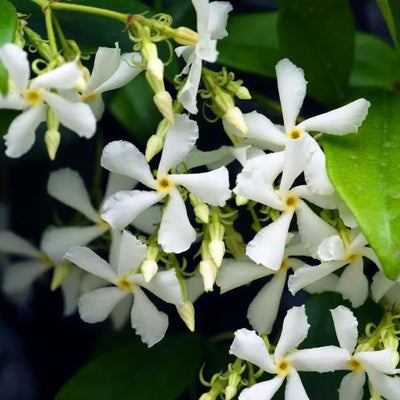Climbing Plants, Vines and Creepers
Order Potted Climbers Now For Year-Round Planting
- When your order is ready: your mail order climbing plants are delivered by next working day courier (not the next working day after ordering!)
- Friendly support: if there is anything wrong with your plants when you inspect them, Contact Us within 5 working days
UK Grown, using peat free compost.
Climbing vines are that great "extra" layer in gardening: the vertical. Whether you’ve got a big shady wall or a small sunny archway to cover, there’s a climbing plant for you!
Climbers are focal points, backdrops, and camouflage in the traditional "English landscape garden", scrambling into trees, hiding unsightly structures like walls and sheds, and growing over a seated area to provide shade, delighting the senses with their blooms and foliage.
Essential climbers include clematis, honeysuckle, jasmine, grape vines, shade-tolerant climbing hydrangea and ivy, and, if you have room for them, Virginia creeper or wisteria.Climbing roses, which technically are not true climbers, are in the rose section.
Mature climbing plants are a haven for insects and nesting birds, and several of them do double duty as ground cover.
They are especially great in the smaller garden, where they take up a small amount of root space relative to their size and impact.
Choosing Climbers
The ultimate people-pleasers are Trachelospermums, known as Star Jasmines (no relation to regular Jasmine): evergreen, low maintenance, loads of flowers with superb fragrance, grows practically anywhere.
If you need something similar but faster growing, the humble Sausage Vine is a great choice.
Like most climbers, Trachelospermums need support wires or a trellis - they will grab onto walls eventually, but it takes quite a long time. Truly self-clinging climbers that grab on as they go include Hydrangea petiolaris, Ivy, and the absurdly vigorous Parthenocissus.
For a breathtaking flower display, climbing roses are the nation's favourite, closely followed by Clematis and Honeysuckle.
Wisteria deserves special mention: not for every garden, this hulk has extraordinary flowers, arguably better than any other climber.
It needs space, strong supports, and trimming twice a year to flower well, but it's all worth it when you're sitting under your pergola with Wisteria blossom raining down around you.
Which Size Pot Should I Buy?
- The bigger the pot, the bigger the plant and the faster it will establish.
- Pots are measured by their volume in litres apart from p9 / 9cm pots, which are a little over half a litre.
- P9 pots are cheapest, but benefit from being potted up and grown on in shelter for their first season.
What about annual & herbaceous climbers?
- Annual climbers are grown from seed every Spring and last for one growing season
- Herbaceous perennial climbers die back to the ground in Winter and return in Spring
Classic examples include the sweet pea, the ornamental bindweeds known as morning glory (various Ipomoea species) and Spanish Flag (Ipomoea lobata), Golden Hops (Humulus lupulus 'Aureus'), or the black-eyed Susan vine (Thunbergia alata).
Growing Climbers
As with property, the first thought with climbing plants should be location.
It is possible to move most climbers if you find they are not right where you planted them originally but, without exception, they will need to be cut back hard.At best, you will lose years of growth. At worst, they will die in the attempt.
Next, consider the final size and the need for sturdy and permanent support, especially with big, heavy vines like Wisteria.
Avoid using thorny climbing roses close to paths, doors and windows: even if you keep them well pruned, someone will stumble right into them eventually.
Like most plants, climbers love diligent soil preparation to add lots of humus and improve drainage. The exception is planting in heavy clay (which ivy loves, for example), where you just loosen up the soil, remove a square portion as big as the pot the plant comes in, pop in the plant and firm the clay back down around the rootball.
Most of them prefer an open airy position, but many coloured clematis look best in partial shade (and all clematis prefer shaded roots), and there are several good options for full shade.
Once you've accounted for all that, then think about flowering season, colour and scent.
Climbing plants should be planted far enough away from their support, or tree host, so that their roots are not outcompeted or too dry.
- With mature trees, try planting a climber under the edge of the tree's canopy, not next to the trunk. You need a sturdy low branch to train the climber onto.
- With walls, plant at least 45cm (better 60cm) away from a wall. The soil immediately next to most walls is poor and dry.
As with any woody plant, we recommend using rootgrow fungi over fertiliser at planting time.








 Secure, One-Tap Checkout
Secure, One-Tap Checkout
 Hand Picked, Delivered to Your Door!
Hand Picked, Delivered to Your Door! 1 Year Bareroot Guarantee
1 Year Bareroot Guarantee













































